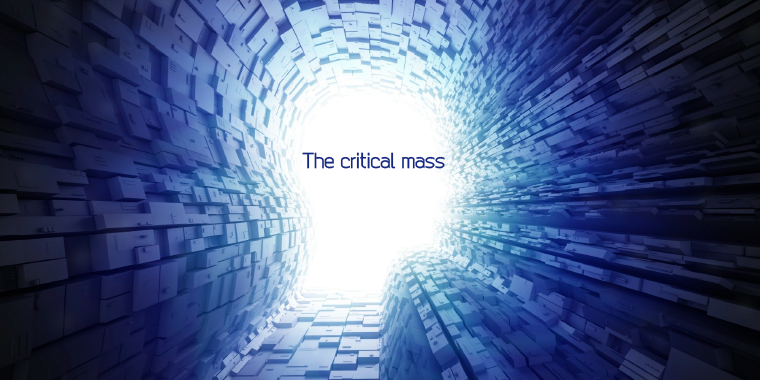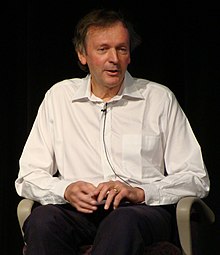
In recent years there has been a shift in the way many people think and act. «This shift» is a harbinger of a new standard of global consciousness. Although the appeasement forces are working frantically for decades, if not more, the «Shift» takes place, despite the adversities and the resistance it’s been facing. And this is so, because the «Critical Mass» for change has been established.
According to Wikipedia, a «critical mass is the smallest amount of a broken-down particle needed to create a nuclear chain reaction». It means the same thing, however, when we are talking on a consciousness level, meaning the capability of an alert mind for spherical and more aware thinking. On an energetic level it’s expressed as a sudden, spontaneous and mysterious leap in the collective consciousness obtained and established when the manifestation of the smallest necessary group of conscious co-creators can bring about this chain reaction. But, let’s take things in order. It all started with a monkey experiment.
The Experiment: The 100th monkey
The idea of the «100th monkey phenomenon» comes from the research of Dr. Lyall Malcolm Watson (1938-2008) in his book «Tide of Life», 1979. The Japanese monkey named Fuscata Macacca or «Snow Monkey» was part of an experiment in the wilderness for a period of at least 30 years. The experiment was conducted in 1952 on the island Koshima, where scientists who were feeding the monkeys discarded sweet potatoes on the ground.
The monkeys liked the raw sweet potatoes, but they did not like the taste of the soil on the potato skins. An 18-month female by the name Imo found that she could solve the problem of the unpleasant soil taste in a nearby stream. In essence, she simply dipped the sweet potato in water and rinsed the soil off. The sweet potato was immediately tastier. Of course, she taught this technique to her mother. Her mother’s friends learned this and in turn, also taught this new way to their mothers and so on. This social innovation was adopted gradually by various monkeys before the scientist’s eyes.
From 1952 and until 1958, all the young monkeys learned to wash the soiled sweet potatoes and make them more palatable by watching other monkeys do the same. Only the adults who imitated their children learned this social evolution. Other adults kept eating the dirty sweet potatoes like before. Then something impressive happened. In autumn of 1958, an unknown number of Koshima monkeys were washing their sweet potatoes in the stream. Suppose, when the sun came out one morning there were 99 monkeys on Koshima Island who had learned to wash their sweet potatoes. Let’s also suppose that later that morning, the hundredth monkey learned to wash the sweet potatoes. And that, brought about the change!

The Japanese macaque, Macaca fuscata, also known as the snow monkey, is a terrestrial Old World monkey species that is native to Japan
By that night, almost all the monkeys in the race were washing their sweet potatoes before eating them. The added energy of this 100th monkey created this important ideological innovation! That is, since the one-hundredth monkey started applying the knowledge of washing the sweet potato, this knowledge was established by almost all the monkeys in the race, automatically. That transaction consolidated a new way of thinking in the collective unconscious of the society of monkeys on the island.
But that’s not all. A surprising observation was made by the scientists when they saw that the habit of washing the sweet potatoes overcame the sea boundaries of the island and spread, as if by magic, to other, nearby islands and beyond. Colonies of monkeys on other islands, including the monkeys on the mainland Takasakiyama began to wash their sweet potatoes without having someone teach them or without watching it done by other monkeys!
Therefore the scientists concluded that when the critical number of people is achieved and this «critical mass» develops a new conscious awareness, this awareness may be communicated from mind to mind, without the in-person «training». Although the precise number necessary to create the critical mass varies from experiment to experiment, the phenomenon of the Hundredth Monkey states that when a particular number of people learn a new way of thinking or acting, this knowledge remains the property of the consciousness of these people. But, there is a point during which, if only one more individual becomes synchronized with this new knowledge, this new way of thinking is reinforced so that this awareness can now be adopted by almost everyone, automatically!
The secrets of the critical mass theory
The secret lies in the «critical mass», in other words, the critical number of pioneers of a new way of thinking, whether these are people or animals. When this number is reached, this paves the way for all other people or animals and the new habit is then generalized automatically as a new way of thinking or acting.
The critical mass figures for Greece who has a population of 10 million or thereabouts, is 316 people and for the whole world, a population of about 5 billion, only 7,100 people, give or take a few. Therefore, it is clear that, only a small number is required and that these few people can change the intellectual climate of a vast area or even the whole planet.
Scientists watching the apes concluded that the minimum number required by each experiment to form the morphogenetic or energy-vibratory field in a thought-form is a stable number. Thought-forms or energy packages are created and directed consciously or unconsciously every time and with every thought by everyone, whether we know it or not. This can change the destiny of a region, nation or the whole world. The critical mass, therefore, is the square root of the one-hundredth of a population.
How is this information transferred?

Sheldrake in 2008 at a conference in Tucson, Arizona
How is any information and subsequently any habit transferred to the residents of other regions, as it happened with the monkeys? The answer to this question lies in a fascinating theory that says that we are all connected in an invisible energy field, where everything that ever existed, exists and will exist is recorded. This is a universal file or a memory vault that contains all the information of what has happened and is happening in the universe and it’s called the «Akashic Records». Interesting, isn’t it? And yet, this is precisely the theory of the famous Cambridge biochemist and plant physiologist, Rupert Sheldrake, who roused an uproar among the scientific community when he made this public.
According to his theory, all information, whether it relates to events, ideas, habits, feelings, forms, galaxies and DNA structure, is stored in a field, such as the electromagnetic field, which is everywhere. So nothing is lost in the universe even if you «die», in the way that we perceive death. It can be transformed from matter into energy, but it’s not lost.
The same applies to our thoughts. We can perceive our thoughts as something fleeting and ephemeral, but the truth is that our thoughts are not immaterial as we like to think, but they are very tangible though not in the physical way we perceive.
So, where do our thoughts go once we’ve stopped thinking about them? They are not lost or destroyed but recorded as code in our DNA and contain all our deeds, emotions and our entire past, present and future. It does not reside only in our minds but it is also recorded somewhere in the universe.
The Akashic Records

Ervin László at the Global Woman Summit – March 5-8, 2021
Rupert Sheldrake’s theory of the «Akashic Records» give very clear answers to metaphysical questions about everything that has happened, was said and formed as thoughts or desires in the minds of all time, which were recorded and continuously are recorded in this universal and essential file that scientists call «Ground Zero». This explains the phenomenon of simultaneous ways of thinking or inventiveness by different people, in different parts of the world.
In his book «Science and the Akashic Field: An Integral Theory of Everything», an international best-seller, Erwin Laszlo, a leading scientist and thinker of our time and professor at the universities of Sorbonne, Yale, Princeton and member of the International Academy of Sciences, Philosophy etc., reveals this in a simple and understandable way. The essential elements of this «Universal Resource File» confirm that everything is connected and leads to a «Singularity» or the idea of a «Creative Force» while at the same time composing an «Integrated Theory of Everything», the big dream and ardent desire of all great sages, from Albert Einstein to Steven Hawking.
And now what?
Therefore, since we consolidated the existence of these files and the idea of a critical mass for the manifestation of this idea of change in our collective unconscious, we have in our hands the key to change. All we are left to do is to decide:
- What do we want to do with this knowledge?
- What are the changes we want to see?
- How can we unlock these changes?
Do we want to take a stand on the side of «solutions» and create a new paradigm of thought and action based on positive thinking, the strengthening of every human, animal or nature and the healing of all negative situations, on all levels or will we remain part of the «problem» insisting in our misery through endless excuses? It is not that hard to decide. So, the only thing left for us to see, is what should be done until the goal is achieved, without counting the time and effort it takes. Come, the idea of a critical mass is calling.
Xenia Ioannidou
Teacher & Consultant of Alternative Therapies
Founder of GrecoDow® Educational Systems




